
In Augmented Reality, Virtual Reality and Mixed Reality News
January 17, 2025 – January’s Consumer Electronics Show (CES) in Las Vegas often sets the tone for what can be expected from the tech industry over the twelve months that follow. With this year’s show now in the rearview mirror, it seems safe to say that 2025 will be the year of the smart glasses.
AI has been hogging the spotlight across tech news cycles for what feels like the last two years, but with the emergence of dozens of new AI-powered eyewear devices in recent months—including many that were showcased for the first time at CES 2025—could this mean it is now XR’s time to shine?
With AI seemingly permeating just about every single industry showcased at CES 2025—from sports and fitness, to gaming, automotive, fintech, and sustainability—it seems AI integration of some sort is now more an inevitability in any new consumer technology product, as opposed to a nice-to-have.
AI smart glasses, of course, are not a new consumer product. Meta’s original Ray-Ban Stories smart glasses first came out in 2021 for example. However, one thing that CES has made clear is that with this year’s latest lineup of AI-powered wearables, any smart glasses that are lacking augmented functionality may now be seen as trailing behind in terms of innovation and features. Coupled with the explosion in popularity of AI wearables, immersive technologies such as AR are now likely to become more mainstream than ever before.
With that in mind, we’ve put together a roundup of some of the most significant XR product announcements and launches made at CES 2025, offering a comprehensive overview of the latest advancements in augmented, virtual, and mixed reality (collectively referred to as “XR”).
Smart Glasses & Augmented Reality
XREAL Unveils One Series AR Glasses with Advanced Features at CES 2025
XREAL introduced its XREAL One Series AR glasses at CES 2025, including the flagship XREAL One Pro and modular XREAL Eye camera. The glasses feature the proprietary X1 Spatial Computing Chip, offering a 57-degree field of view (FoV) for the One Pro and 50-degree FoV for the standard One. The One Pro’s advanced flat-prism optical design enables an immersive cinematic display in a slim, lightweight frame.
Additional features include adjustable interpupillary distance (IPD), TÜV Rheinland certifications for eye safety, and audio fine-tuned by Bose. The modular XREAL Eye camera supports first-person video capture and will enable multimodal AI capabilities later this year. Priced at USD $599, the One Pro is available for pre-order and will ship by Q2 2025. Demonstrations highlighted immersive use cases, including entertainment and productivity scenarios.
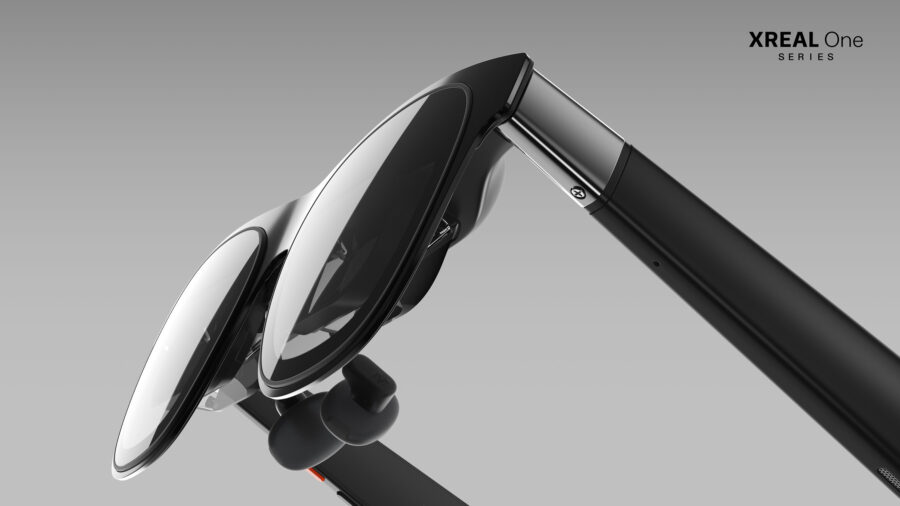
Halliday Introduces Stylish Smart Glasses with Proactive AI and Innovative Display
Halliday unveiled its smart glasses, blending retro design with cutting-edge technology. Featuring the DigiWindow, a 3.6mm near-eye display module, the glasses project a private 3.5-inch virtual screen visible only to the wearer, offering clear visuals even in bright sunlight. Weighing just 35g, they deliver 8-12 hours of battery life and support prescription lenses for versatile daily use, according to the company.
The glasses incorporate a ‘Proactive AI Agent,’ designed to analyze conversations, anticipate user needs, and provide real-time insights. Halliday stated that capabilities include live language translation (up to 40 languages), navigation, voice-to-text note-taking, notifications, and a discreet teleprompter. Users control features via a touch-sensitive frame or a ring with a built-in trackpad.
Set to ship by March 2025, Halliday’s smart glasses will retail between USD $399 and $499 and are currently available on Kickstarter. The new glasses also offer consumers a sleek alternative option to the popular Ray-Ban Meta smart glasses (which themselves lack any form of display) in the growing AR eyewear market.
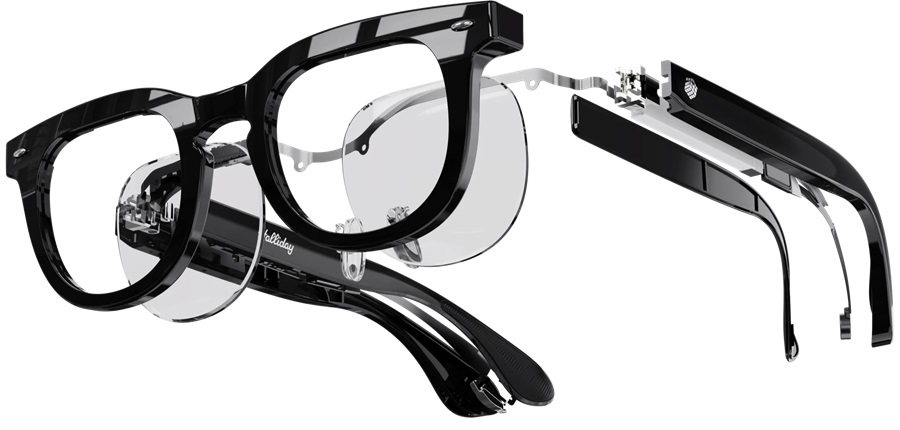
RayNeo Unveils New AR Glasses Lineup
RayNeo introduced three new AR devices at CES 2025: the flagship RayNeo X3 Pro, the lightweight RayNeo Air 3, and the content-focused RayNeo V3, designed to blend accessibility and innovation in augmented reality. The X3 Pro features RayNeo’s proprietary micro-LED optical engine, delivering 2,500 nits brightness, vivid color accuracy, and clarity through Applied Materials’ waveguide technology. Its dual-camera system allows for AI-driven functionalities like hand tracking and SLAM.
The Air 3 offers a 154% sRGB color gamut, 109% NTSC coverage, and a high-contrast birdbath display for immersive visuals. Its dual-opposing acoustic chambers and TÜV Rheinland-certified eye comfort optimize all-day usability. The V3, equipped with a 12MP HDR camera, supports content creation with advanced audio capture and AI tools. The X3 Pro and Air 3 are slated for mid-2025, with the V3 launching later.
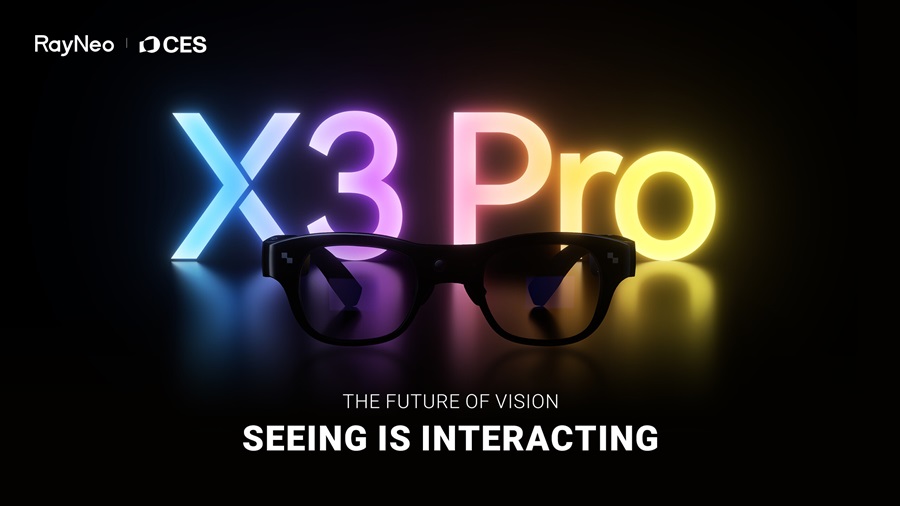
Rokid Showcases AR Spatial, Rokid Glasses and Smart Tour Solutions
Rokid presented its latest AR products and solutions including the company’s AR Spatial, Rokid Glasses, and Smart Tour Solutions. These offerings highlighted Rokid’s vision for accessible and impactful augmented reality applications across entertainment, productivity, and cultural experiences.
The AR Spatial, a combination pack consisting of the Rokid Max 2 glasses and Rokid Station 2, features a 300-inch micro-OLED display as well as intelligent myopia and pupillary adjustment functionality. Rokid Glasses, weighing just 49 grams, integrate AI and AR capabilities for language translation, object recognition, and real-time navigation. The company also displayed its Smart Tour Solutions, which leverage AI and AR to enhance tourism with 3D holographic guides and virtual reenactments, implemented in iconic sites like the Forbidden City.
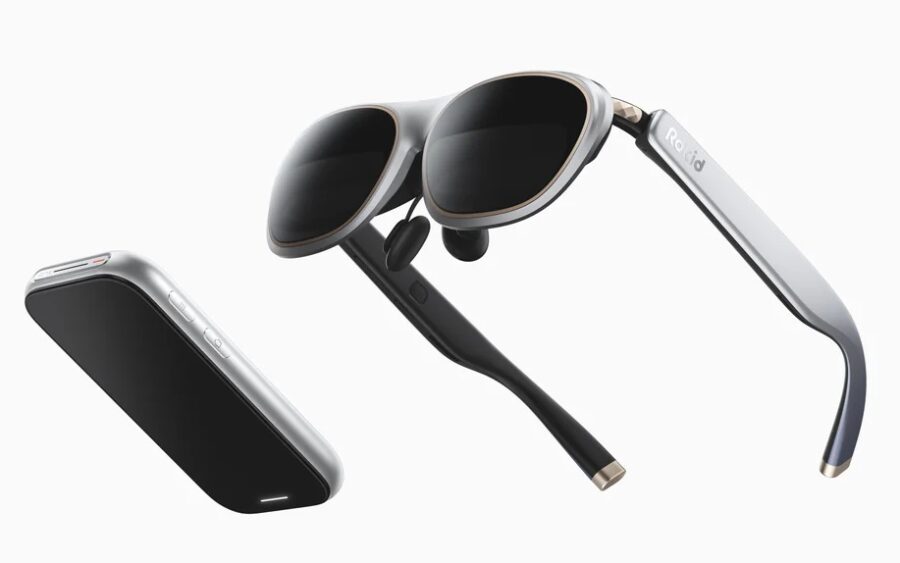
AeroBand and Rokid integrated AR for music education and performance
AeroBand and Rokid announced a collaboration aimed at revolutionizing music education and performance through augmented reality. Through the integration of AeroBand’s smart guitar and PocketDrum with Rokid’s AR Spatial glasses, users can access real-time chord diagrams, drum patterns, and dynamic visual effects for immersive and interactive learning through augmented reality. The AeroBand Guitar features silicone strings for easy chord learning, nine tone options, and a portable design, while the PocketDrum delivers a virtual drumming experience.
Virtual Reality
Roto VR’s Explorer Chair Enhances VR Immersion
Roto VR presented its Roto VR Explorer chair, a motorized gaming chair designed for VR users. Featuring patented “Look & Turn” technology, the chair rotates up to 21 revolutions per minute based on head movements detected by a Bluetooth-connected tracker. This dynamic synchronization helps to eliminate motion sickness by aligning visual and inner-ear cues. The chair is compatible with Meta Quest headsets and other VR devices, with Apple Vision Pro support apparently also coming soon.
The chair enhances immersion with a haptic feedback system embedded in the leather seat, delivering vibrations to simulate in-game effects like explosions. It also includes adjustable height, a footrest, and built-in headset charging. Designed for hardcore VR gamers, the Explorer integrates with 400+ Meta Quest apps and is available for USD $799. Pro upgrades are expected in August 2025.
NVIDIA Expands GeForce NOW to XR Devices, Including Apple Vision Pro and Meta Quest
NVIDIA, in collaboration with Apple, Meta and ByteDance, announced expanded GeForce NOW support for Apple Vision Pro, Meta Quest 3/3S, and Pico mixed-reality devices. As a result, these XR platforms can now be transformed into immersive gaming theaters, allowing users to stream AAA titles on massive virtual screens. The experience supports gamepad-compatible titles, RTX, and DLSS technologies, offering high fidelity and low latency for an enhanced visual experience. Users will be able access the cloud gaming platform via the GeForce NOW browser at play.geforcenow.com starting later this month with the 2.0.70 app update. The announcement highlighted NVIDIA’s continued efforts to integrate XR technologies into the gaming landscape.
Disguise, Nikon and MRMC Partner Enabling Brands to Create Immersive Content
Disguise partnered with Nikon and MRMC to present the “Studio Extreme” activation at CES 2025. Featuring Studio Pro by Disguise, the turnkey virtual production solution allowed participants to deliver live weather reports in a simulated Vegas environment, showcasing how brands can create high-fidelity content such as ads and live streams.
The activation demonstrated the integration of virtual and augmented reality workflows, along with cutting-edge virtual production technology, including MRMC’s StudioBot robotic camera arm, RED Komodo 6K cameras, and advanced lighting and audio systems.
OPTIX Introduces EPIC 50 AR Waveguide Module and 8K VR Foveated Rendering Feature
OPTIX, a Beijing-based optical technology company, revealed two major innovations at CES 2025. The company introduced the EPIC 50 AR waveguide module, which offers a 50-degree field of view (FoV) and full-color, high-efficiency display performance. Designed to support AI-powered AR glasses, this module aims to enhance visual clarity and expand the capabilities of consumer-focused AR devices.
Additionally, OPTIX updated its 8K VR Pancake Module with a foveated rendering feature. This technology integrates eye-tracking to optimize GPU usage, maintaining full 8K resolution while enhancing adaptability. The module features a 115-degree FoV and built-in diopter adjustment, which, according to OPTIX, rivals Apple’s Vision Pro in performance.
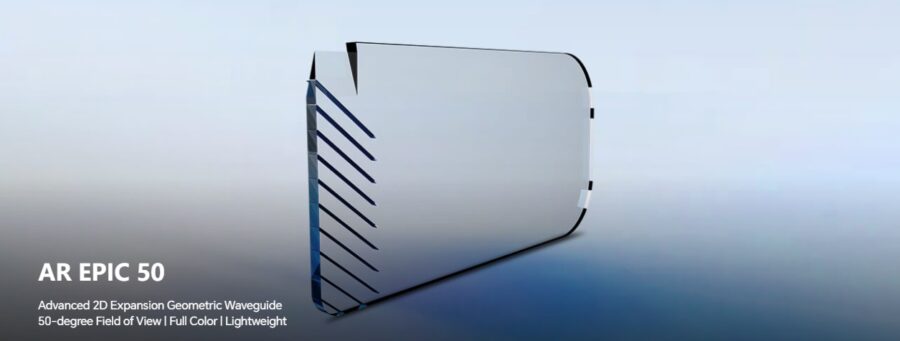
DPVR Unveils P2 Vision Headset and XR Innovations
DPVR introduced the P2 Vision headset at CES 2025, along with existing VR solutions for healthcare, education and entertainment. Equipped with Ganzin’s Aurora II eye-tracking module, the P2 Vision features less than 1.5° tracking error according to the company, along with adjustable IPD, and a lightweight design for enhanced comfort. With SDK support and long battery life, the P2 Vision suits diverse applications in healthcare, education, and entertainment.
DPVR also showcased its E-Series headsets, highlighting the E4 Arc with Ultraleap hand-tracking, and VR arcade systems like Virtual Rabbids and Godzilla Kaiju Wars VR. In healthcare, DPVR demonstrated immersive surgical simulations, emphasizing stoma care training.
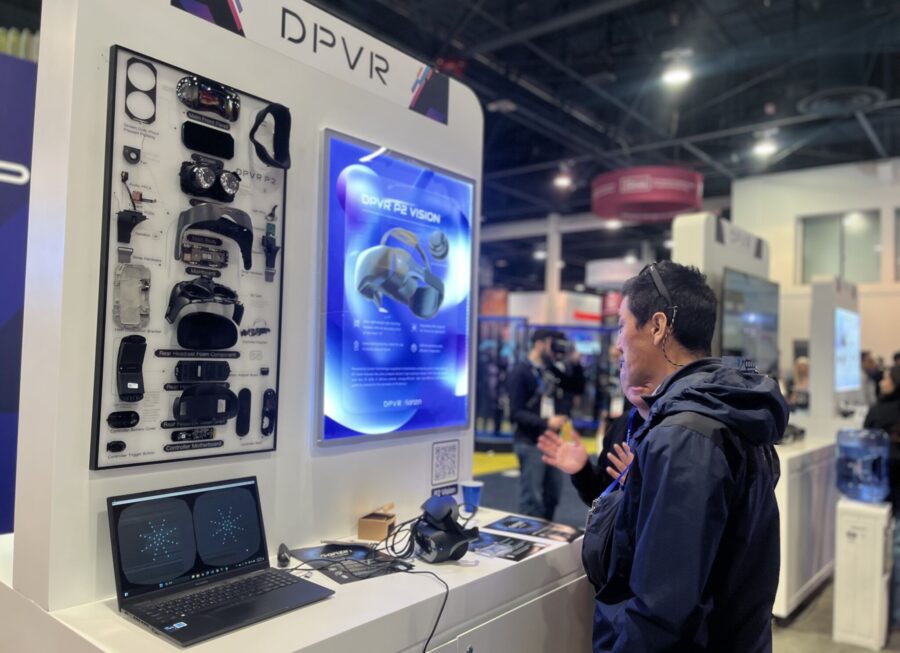
Mixed Reality
Play For Dream Unveils Android-Based MR Spatial Computer
Play For Dream Technology debuted its Play For Dream MR headset, an Android-based spatial computer featuring eye-tracking, auto-IPD, pancake lenses, and lifelike visuals. Powered by the Snapdragon XR2+ Gen 2 platform and featuring an 8K microOLED display, the device integrates Tobii’s XR5 eye-tracking technology and looks strikingly similar to Apple’s Vision Pro headset. Some even gave it the moniker “Android Vision Pro.”
Play For Dream showcased consumer and B2B solutions on the headset covering a range of industries including healthcare, education, and aviation. The device also garnered a lot of praise from attendees and press over the course of the week for its hardware and software performance. Play For Dream MR is slated to launch in the US in March 2025.
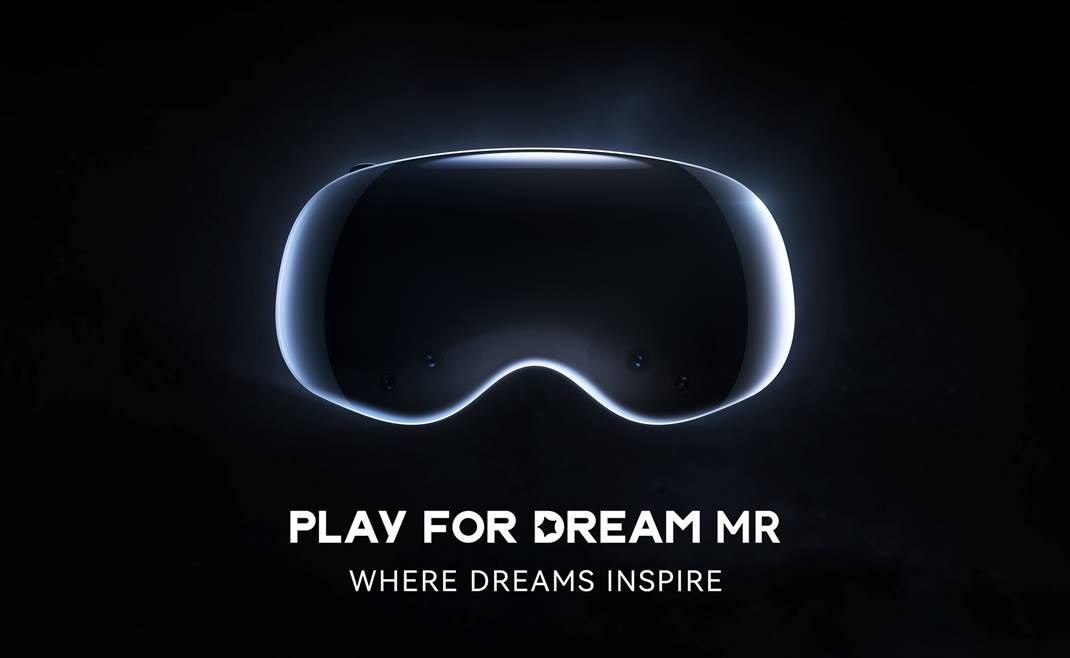
Sony Launches XYN Platform for Spatial Content Creation
Sony unveiled XYN (pronounced “zin”), its new software and hardware solution for spatial content creation. The XYN ecosystem includes the XYN Headset (a 4K OLED-equipped AR/VR prototype, which we actually got to try an early version of at last year’s CES), XYN Spatial Capture for photorealistic 3D asset creation, and XYN Motion Studio, which enhances motion capture precision via Sony’s mocopi sensors.
Targeted at industries like gaming, animation, and industrial design, XYN streamlines 3D workflows with tools for creating virtual objects, environments, and motion data. Collaborating with Siemens, Sony also highlighted the headset’s enterprise applications in the industrial metaverse, enabling tasks like immersive 3D modeling. While the XYN Headset still remains a prototype, Siemens has apparently begun pre-orders for its own variant, costing USD $4,750 for end users.

Soliddd Unveils Vision-Restoring Smartglasses for Macular Degeneration
Soliddd introduced its SolidddVision smartglasses, showcasing what the company states is the first vision correction technology for macular degeneration. The glasses use proprietary lens arrays, dual cameras, and AI-driven software to project over 100 focused views onto undamaged areas of the retina, allowing the brain to construct a full-field, 3D image with improved acuity.
Designed for everyday wear, the lightweight glasses demonstrated significant benefits in clinical studies, including a 50% improvement in reading ability for many participants. Supported by medical experts, the technology has been described as life-changing for users with vision loss. SolidddVision targets over 200 million people worldwide with low vision, promising to transform daily experiences for those affected by macular degeneration.

Even Realities Showcases G1 and G1B Smart Glasses
Although not strictly a new announcement, Even Realities is still worth a mention when it comes to smart glasses on display at CES 2025. The company showcased its G1 smart glasses, which have been around for a few months now, as well as an alternative G1B variant. Both models feature waveguide displays with a 25-degree field of view, and pair with a smartphone to offer real-time navigation, translation, and captioning capabilities. With a lightweight, comfortable design and apparent modular repairability, the glasses start at USD $599.
XR Enabling Technologies
XREAL Partnerships and Collaborations
In addition to showcasing its XREAL One Series AR glasses and Beam Pro handheld spatial compute device, XREAL also highlighted several strategic partnerships at CES. Key collaborators include BMW, Google, Qualcomm, Bose, T-Mobile, and Mawari, each contributing unique capabilities to enhance XREAL’s product ecosystem. The company also announced a distribution partnership with AT&T, with the XREAL One glasses available via its online storefront this month.
BMW Debuts Panoramic iDrive with Advanced HUD Technology
BMW unveiled its Panoramic iDrive system, integrating spatial computing into automotive experiences. Central to the system is the “Panoramic Vision” component, a windscreen-wide display that projects personalized content for both drivers and passengers. Complementing this is an optional 3D Head-Up Display (HUD), which integrates navigation and assisted driving visuals directly into the driver’s field of view. Powered by the in-house BMW Operating System X, the system enhances driver interaction through customizable driving modes and natural language processing thanks to an integrated Large Language Model (LLM).
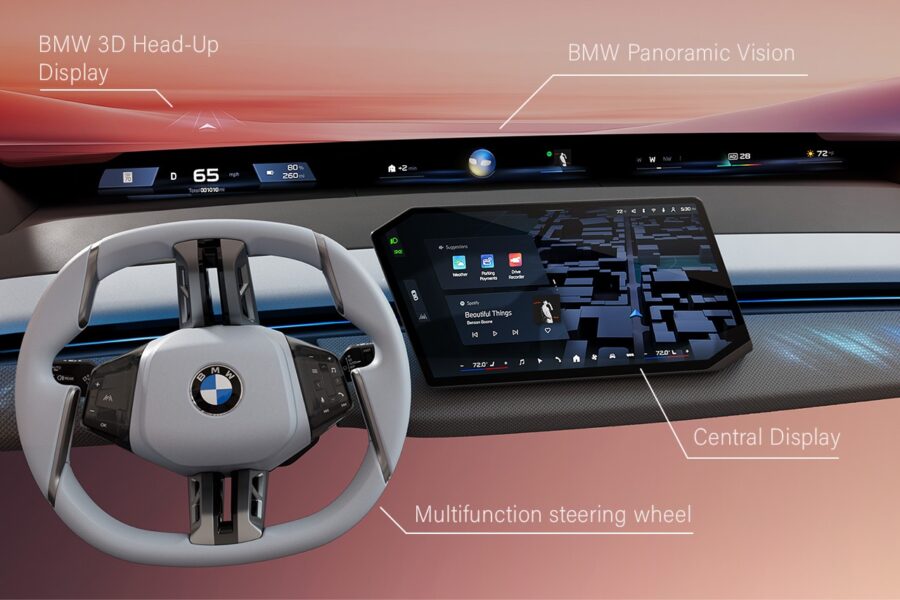
Razer Unveils Immersive Gaming Innovations
Razer showcased its Immersive Ecosystem, blending THX Spatial Audio, Chroma RGB lighting, and Sensa HD Haptics for or next-level gaming experiences. Highlights at the company’s booth included the Razer Handheld Dock Chroma for transforming mobile devices into gaming consoles, PC Remote Play for streaming high-resolution PC games on mobile devices, and the Razer Blade 16 gaming laptop, featuring NVIDIA GeForce RTX 5090 GPUs in an ultra-thin frame. Razer emphasized its commitment to merging high-performance hardware with immersive design to transform gaming into a “fully immersive experience.”
Aledia Unveils MicroLED Technology for Immersive AR Experiences
Aledia unveiled its 3D GaN-on-Si microLED platform, promising thinner, brighter, and more energy-efficient displays for augmented reality applications. According to the company, its microLED platform delivers superior brightness, directivity, and resolution, addressing key challenges in AR hardware like power consumption and bulkiness.
With a USD $200M microLED production facility in Grenoble, France, Aledia aims to scale cost-effective manufacturing for mass adoption of AR smart glasses and displays. The company’s president and CEO Pierre Laboisse even went so far as to state that by next CES, OLED and LCOS will “already be phased out” in favor of Aledia’s “superior” microLED technology. We’ll have to wait until next year to find out if this is the case.

Innoactive Showcases Omniverse XR Streaming on Apple Vision Pro
Innoactive, leveraging NVIDIA Omniverse, debuted XR Streaming for Apple Vision Pro, enabling photorealistic 3D rendering and real-time collaboration for digital twin workflows. The company’s spatial streaming solution combines hybrid rendering and OpenUSD, allowing users to stream massive datasets with clarity and efficiency. Innoactive showcased immersive use cases such as design reviews and optimized system layouts across industries including automotive and pharmaceutical manufacturing.
About the author
Sam is the Founder and Managing Editor of Auganix. With a background in research and report writing, he has been covering XR industry news for the past seven years.
